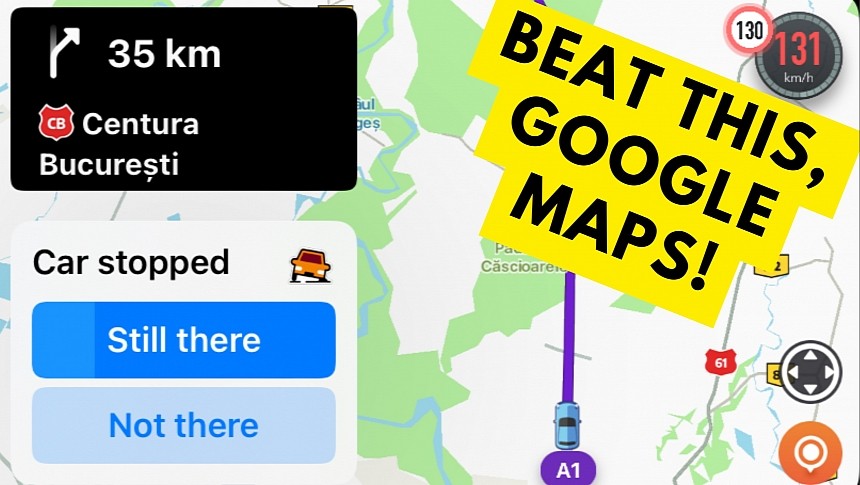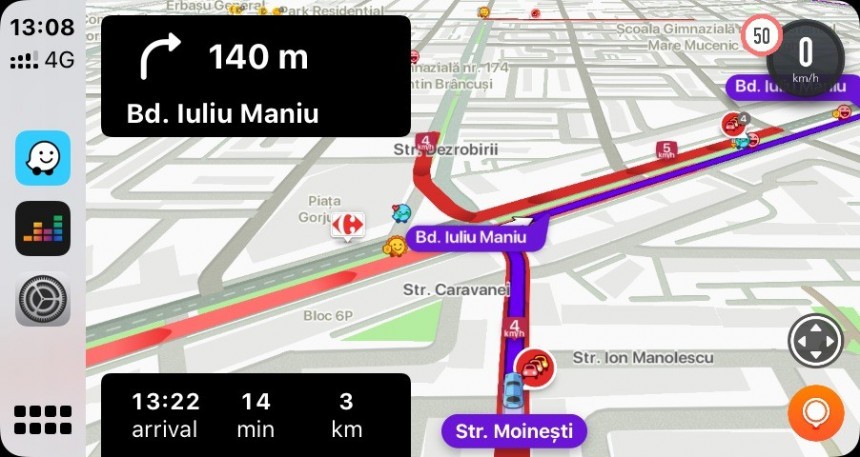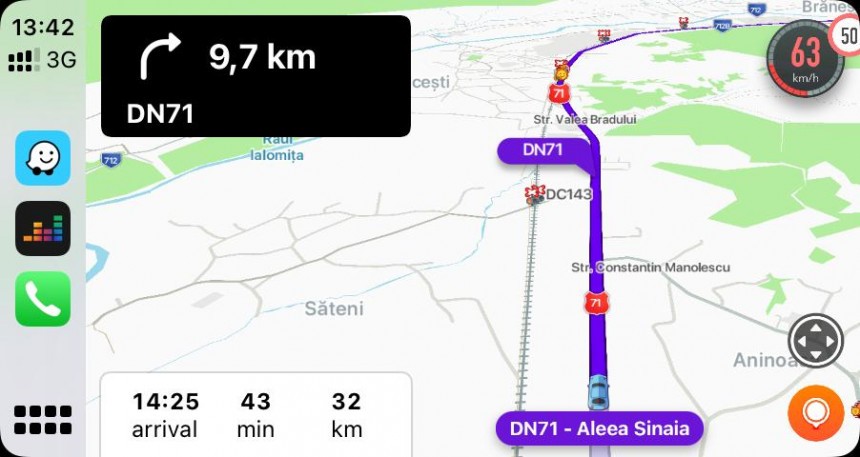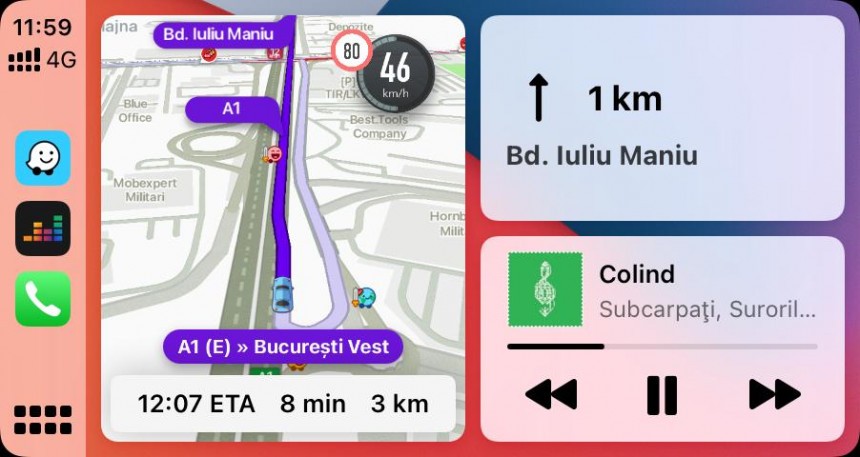Waze might look like "just another navigation app" at first glance, but in reality, the Google-owned software provides a more advanced feature package that you won't find elsewhere.
The magic resides in the crowdsourcing engine that allows users to send traffic reports. At the same time, the application also collects traffic data from their devices (with or without active navigation), always trying to find the fastest route to the destination.
By default, Waze favors the main road if using secondary streets does not produce a substantial gain. In other words, if a route using multiple secondary streets is only one minute faster but makes the route more complex, Waze could recommend users stick with the main roads.
Waze also handles the location of traffic lights and stop signs differently from other navigation apps.
The first thing you must know is that Waze does not record the location of traffic lights and stop signs for a simple reason: its routing engine doesn't think this data is relevant to how routes are calculated.
Waze was designed to look for faster routes, so it doesn't care about the location of traffic lights. Instead, it's particularly interested in the impact on traffic conditions, so the application doesn't look at the location of a traffic light but how it slows down traffic. Waze always looks for the fastest route, so if a traffic light produces a significant slowdown and long waiting lines, the application eventually searches for an alternate route.
The longer the queue at a traffic light, the bigger the impact on traffic. Waze could eventually flag the road segment before the traffic light as "slow," so the application would no longer favor the main road over secondary streets.
The complex analysis that eventually provides users with faster routes also takes into account the average speed on the streets around a slow road. Once it compares the average speeds on all available roads, Waze can look for a faster route to the defined destination. Sometimes, the suggested route could be longer, but the ETA could be shorter because Waze avoids the road segments affected by slowdowns.
Traffic lights are often located on roads with a low average speed, especially at rush hours. It's the main reason Waze sends drivers to secondary streets, eventually producing disruption in small and quiet neighborhoods. These routes could be more complex, posing a challenge for rookie drivers, but the average driving time could be significantly shorter (remember that Waze does not suggest an alternate route unless it provides a substantial gain).
In some cases, Waze could still recommend drivers to use the main roads with traffic lights and heavy traffic. The application doesn't look for routes that do not include traffic lights, but for faster routes – traffic lights generate slow traffic, so Waze removes them from its routing engines. However, if side streets can't handle the high traffic volume, eventually getting full of vehicles trying to avoid the traffic lights, Waze keeps users on the main roads. It all comes down to the average speed information that it's permanently scanning. The fastest route is always favored, even if it includes traffic lights with long queues.
Google Maps uses a similar approach but doesn't always ignore the location of traffic lights. The application also provides guidance based on traffic light location, making navigation more straightforward.
However, Google Maps doesn't always look for the fastest route, as it also generates fuel-efficient options for drivers who want to reduce the carbon footprint of their vehicles. With this setting enabled, Google Maps uses additional data for its routing engine, including the road incline. As a result, the traffic light location is no longer relevant, so Google Maps might keep you on the road full of traffic lights as long as the application estimates that the route generates important fuel savings.
For example, Google Maps might not recommend drivers to wind through side streets but instead favor stop-and-go traffic if they own a hybrid car. Running at low speeds allows a hybrid vehicle to use its electric motor without the gas engine kicking in for additional power.
The fuel-efficient route is unlikely to be faster than the default option, especially when dealing with heavy traffic.
Waze automatically recommends faster routes, but I discovered that manually searching for new routes could provide you with shortcuts not included in the initial suggestion. Theoretically, the method forces Waze to search for alternate routes faster than the automatic re-routing system, helping the application reduce the time between re-checks of average speed information.
Waze works similarly on Android and iPhone, so the same routing system powers the application regardless of your mobile platform – Android Auto and CarPlay are phone projection systems, so the navigation experience is powered by the mobile device (which means the application is running at the smartphone level and not in the car).
By default, Waze favors the main road if using secondary streets does not produce a substantial gain. In other words, if a route using multiple secondary streets is only one minute faster but makes the route more complex, Waze could recommend users stick with the main roads.
Waze also handles the location of traffic lights and stop signs differently from other navigation apps.
Waze was designed to look for faster routes, so it doesn't care about the location of traffic lights. Instead, it's particularly interested in the impact on traffic conditions, so the application doesn't look at the location of a traffic light but how it slows down traffic. Waze always looks for the fastest route, so if a traffic light produces a significant slowdown and long waiting lines, the application eventually searches for an alternate route.
The longer the queue at a traffic light, the bigger the impact on traffic. Waze could eventually flag the road segment before the traffic light as "slow," so the application would no longer favor the main road over secondary streets.
The complex analysis that eventually provides users with faster routes also takes into account the average speed on the streets around a slow road. Once it compares the average speeds on all available roads, Waze can look for a faster route to the defined destination. Sometimes, the suggested route could be longer, but the ETA could be shorter because Waze avoids the road segments affected by slowdowns.
Traffic lights are often located on roads with a low average speed, especially at rush hours. It's the main reason Waze sends drivers to secondary streets, eventually producing disruption in small and quiet neighborhoods. These routes could be more complex, posing a challenge for rookie drivers, but the average driving time could be significantly shorter (remember that Waze does not suggest an alternate route unless it provides a substantial gain).
Google Maps uses a similar approach but doesn't always ignore the location of traffic lights. The application also provides guidance based on traffic light location, making navigation more straightforward.
However, Google Maps doesn't always look for the fastest route, as it also generates fuel-efficient options for drivers who want to reduce the carbon footprint of their vehicles. With this setting enabled, Google Maps uses additional data for its routing engine, including the road incline. As a result, the traffic light location is no longer relevant, so Google Maps might keep you on the road full of traffic lights as long as the application estimates that the route generates important fuel savings.
For example, Google Maps might not recommend drivers to wind through side streets but instead favor stop-and-go traffic if they own a hybrid car. Running at low speeds allows a hybrid vehicle to use its electric motor without the gas engine kicking in for additional power.
Waze automatically recommends faster routes, but I discovered that manually searching for new routes could provide you with shortcuts not included in the initial suggestion. Theoretically, the method forces Waze to search for alternate routes faster than the automatic re-routing system, helping the application reduce the time between re-checks of average speed information.
Waze works similarly on Android and iPhone, so the same routing system powers the application regardless of your mobile platform – Android Auto and CarPlay are phone projection systems, so the navigation experience is powered by the mobile device (which means the application is running at the smartphone level and not in the car).










